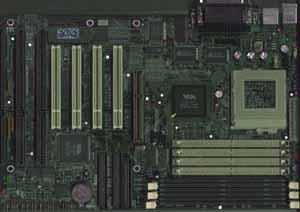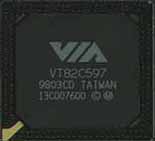Tyan Trinity ATX MVP3 Super7 Board
by Anand Lal Shimpi on April 12, 1998 12:26 PM EST- Posted in
- Motherboards
| CPU Interface | Socket-7 |
| Chipset | VIA VP3 |
| L2 Cache | 512KB |
| Form Factor | ATX |
| Bus Speeds | 60 / 66 / 75 / 83 MHz |
| Clock Multipliers | 1.5x / 2.0x / 2.5x / 3.0x / 3.5x / 4.0x / 4.5x / 5.0x |
| Voltages Supported | 2.1v / 2.2v / 2.7v / 2.8v / 2.9v / 3.2v / 3.3v / 3.4v / 3.5v |
| Memory Slots | 4 72pin SIMM Slots
(EDO/FPM) 3 168pin DIMM Slots (EDO/SDRAM) |
| Expansion Slots | 1 AGP Slot 4 PCI Slots 3 ISA Slots (1 Shared / 3 Full Length) |
| BIOS | AWARD PnP BIOS |

| The Tyan Trinity S1592S ATX is the next step in a clean break from the traditional Tyan motherboard design, based on the VIA VP3 chipset and sporting a roomy 512KB of L2 cache the Trinity ATX breaks the traditional 64MB cacheable memory area of Intel TX based boards expanding it to 128MB due to the size of the Tag RAM included on the board (in Write Back mode). The chipset provides for all of the features the Intel TX chipset supports, while adding support for the Accelerated Graphics Port. |  |
| The Trinity ATX is much like the Shuttle HOT-595, according to Tyan it supports bus speeds up to 83.3MHz although the model tested here wouldn't recognize the 83MHz setting when jumpered to it as according to the User's Manual. The Trinity ATX does stick to Tyan's established policy of placing expandability as one of their highest priorities, the 4 PCI, 3 ISA, 3 DIMM and 4 SIMM slots are plenty for most users...pushing this board to its limits should be a challenge for even the most power users. | |
Supporting clock multipliers from 1.5x - 5.0x and the desperately sought after 2.2v core voltage setting, the Tyan Trinity ATX managed to grab the title of the First K6/266 Approved Motherboard from AMD. Configuring the Trinity ATX for use with the K6/266 or any of the supported Socket-7 processors isn't too difficult, Tyan didn't choose to travel the Jumperless path with the Trinity ATX, which is perfectly fine since the written documentation takes care of virtually all worries first time builders will experience. The manual follows the classic Tyan layout which, when simply put, is outstanding at the least.
Tyan chose to include 2 - 3.5" Floppy Disks in the plain white cardboard box housing the Trinity ATX from your vendor, these two disks hold all the data you need to get your system up and running. On the first disk are the latest version of VIA's Bus Mastering Drivers, a wonderful addition to the package since many users don't have the time to search around the net for the drivers. The final disk has the VIA AGP Gart VxD, also a useful addition.
The board itself is the victim of a edge to edge packed layout, however Tyan made sure that the ease of installation and configuration wasn't penalized too greatly because of this. Due to the placement of the EIDE connectors, two of the 4 PCI slots cannot accept full length cards without bending any installed IDE cables beyond a desirable degree. The other two PCI as well as the 3 ISA slots can accept full length cards without any problems at all. The Trinity ATX also features the Green Power LED that seems to have gained popularity with its presence on Tyan motherboards, as to how useful it is...that's another topic.
Dealing with stability, the Trinity ATX had no problems holding its ground, at overclocked and under normal operation the S1592S performed flawlessly never showing any signs of weakness under heavy usage or stressful operation. Performance-wise, the Tyan board was just about on par with all the other boards in its price/feature class, ranking among the best VP3 boards out today. Its only real competition being the Shuttle HOT-595 which has the board beat in terms of ease of setup/configuration.
Like the Shuttle HOT-595, the Trinity ATX tested here didn't have a working 83.3MHz bus speed setting, which is a disappointment, although the 75MHz setting worked flawlessly. The performance with the Trinity ATX and the Pentium MMX does seem to be quite under par, however the VP3 chipset was never intended to be a blazing fast Intel processor platform. Other than that the Tyan Trinity doesn't seem to have any real downsides when compared to other boards in its class.










0 Comments
View All Comments